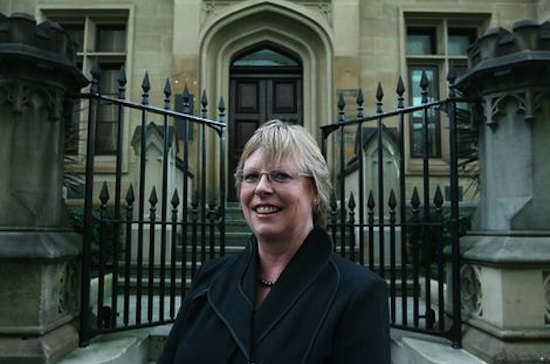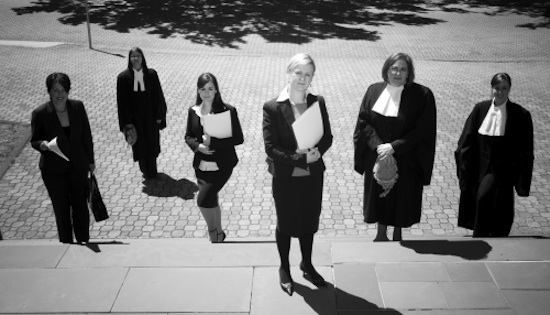Another step in the search for gender equality in legal practice ... "Thought leadership" from the NSW Law Society ... More of the same ... Inquiries needed into the role of men and the management of law firms ... Attrition and reengagement ... Alix Piatek reports
 Justice Ward: It's possible to be in two places at once
Justice Ward: It's possible to be in two places at once
NSW Supremo Justice Julie Ward told a group of femmes earlier this month not to look for prejudice or bias in the workplace - it might just be "part of your imagination".
HH pointed to an incident where she was addressed as "his honour" by senior counsel.
"Don't assume that your gender is immediately apparent ... whatever criticism he had of my judgment he could not have blamed it on my gender."
She was speaking on July 5 at the launch of the latest progress report on the Advancement of Women project - first published in 2011 as part of the NSW Law Society's "flagship thought leadership initiative".
The initiative seeks to create a "positive impact on the experiences of women solicitors".
A series of recommendations were made in 2011 and an update on progress was promised and has now been delivered.
As a woman with over 30 years experience in the law game, Justice Ward proffered some advice.
She urged women juggling the work-life balance to take note: it is possible to be in two places at once.
"A witness once explained the discrepancy as to her whereabouts at a particular time by reference to the fact that since she was on the telephone to her husband who was overseas, she was overseas at the time.
I have found that a helpful argument when being chastised for being late home - if I call from chambers to say I am on the way then by that logic I am already home."
From the latest report it was difficult to quantify what concrete advancements for women have been achieved.
Much of the difficulty lies bogged in deep-seated discriminatory attitudes and ingrained cultural "values" - which lie beyond endeavours at better networking, roundtable discussions and leadership events.
The 2011 "thought leadership" agenda spelled out 12 recommendations. While most seemed quite fluffy, it was nonetheless a start:
- Publish tips for practitioners arising from roundtable discussions;
- Publish information to assist practitioners considering flexible work arrangements;
- Host a thought leadership event which profiles the advancement of women across the profession;
- Deliver a CPD session for women returning to work after parental leave;
- Develop an online resource for practitioners absent from work;
- Improved mentoring;
- A workshop for women who want to improve their business development or "personal networking skills";
- Gender research and
- Updated statistics.
 More workshops and networking sessions
More workshops and networking sessions
The latest figures show the attrition rate for women solicitors across the profession is at an all time low of 29.6 per cent.
However, is there a connection between the fulfillment of these recommendations and lower attrition rates for women solicitors?
Other factors have been at play - the state of the legal market, fewer people entering the profession and a greater-than-ever need for people to stay in income producing employment.
The latest report says that the attrition rate is at a 10 year low for both male and female solicitors.
For both there has been a substantial drop in the number of individual solicitors holding practising certificates after the first five years of practice.
For women, the decrease in the first five years has only been slightly higher than for men.
In 2011, the Law Society said:
"Overall, it appears there is little difference between the rates at which men and women solicitors leave the profession.
However, analysis of each segment of practice suggests that more young women solicitors are leaving private practice than young men and that some of these women appear to be moving to in-house roles."
In other words, the trend has not changed between the "thought leadership" reports of 2011 and 2013.
 The face of justice - and she's not blind
The face of justice - and she's not blind
However, the number of female solicitors has increased much faster than the number of males, "with women now making up 47 percent of the practising profession".
At mid to top-tier firms only 25 per cent of senior management are women.
In 2012, 23 percent of private practice principals were women, up from 17 percent in 2003.
The Law Society stats show that women comprised 41 percent of all first time private practice principals in 2012.
That means that women become partners in almost the same proportion they are represented in the whole law practice population.
However, the rate is lower when single partner firms are excluded, so that women constituted 34 percent of first-time principles in firms with two or more partners.
The Women Lawyers' Association of New South Wales said the Law Society met all of the 2011 recommendations, and that has prompted the call for further women-friendly initiatives.
This is a case of more of the same, with mentoring, return to work workshops, a guide to flexible working hours and networking events all getting a re-run.
Justice Ward said women should seek guidance about flexible hours from the women who have already had to negotiate part-time work for themselves.
No suggestions were readily forthcoming on how to quell the "working mother guilt complex".
Justinian leafed through the flexible working publication and found hints that some lawyers might think smack of the obvious:
"Be prepared to make a business case for flexible working. You are more likely to be successful if there are benefits for your employer as well as you ...
Make working off-site a practical reality by providing effective access to technology ...
Don't overestimate the resistance of clients to flexible working arrangements. Talk to them."
The step-by-step guide on how to ask the boss for flexible hours can be found here.
Not to be outdone by the Law Society, the Law Council of Australia is now in on the act.
In February, Justinian reported the Law Council's plans for a National Attrition and Re-engagement Study.
It was officially launched in May and Joe Catanzariti, the then Law Council prez, said women will be able to talk openly about their experiences in the profession.
"At the end of the study, a report will be produced outlining practical measures which can be implemented to address the causes of high attrition rates among women lawyers, and re-engage women lawyers who have left the profession."
Submissions closed on May 31, so a whole bunch of "practical" recommendations are being created right now.
The Law Institute of Victoria was ahead of the game, releasing a report last December on women in the legal profession, with the Victorian Equal Opportunity and Human Rights Commission.
Among the findings:
"Women are exiting the legal profession because of systemic discrimination and cultural and structural factors."
So many of the reports, recommendations and initiatives for equality in the profession are really reploughing the same old turf.
And wymyn barristers? They have been left out of the Victorian and NSW research so far, but are likely be swept-up in the LCA's "practical measures" study.
Race and sex are not qualifications or disqualifications for any job, although Julie Ward did find it "difficult to imagine a female sperm donor".
Basically, there should be studies and reports into the men who dominate legal practice and why there are not more of them making it possible for women with children to have fulfilling professional lives.
Reporter: Alix Piatek
Information sources
NSW Law Society
Law Council of Australia
National attrition and reengagement study
Justinian's reports
ABC